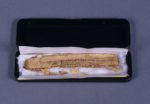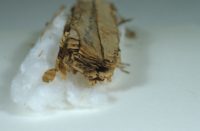 The Library of Congress has conserved and digitized an extremely rare 2,000-year-old Buddhist scroll. The scroll was written in carbon ink on strips of birch bark in Gandhara, an ancient Buddhist kingdom in the Peshawar Valley, today the northern borders of Pakistan and Afghanistan. Dating from between the 1st century B.C. and the 1st century A.D., it is one of the oldest known Buddhist manuscripts.
The Library of Congress has conserved and digitized an extremely rare 2,000-year-old Buddhist scroll. The scroll was written in carbon ink on strips of birch bark in Gandhara, an ancient Buddhist kingdom in the Peshawar Valley, today the northern borders of Pakistan and Afghanistan. Dating from between the 1st century B.C. and the 1st century A.D., it is one of the oldest known Buddhist manuscripts.
 The Gandhara Kingdom was one of the earliest centers of Buddhism after it moved out of India and Gandhara monks were instrumental in the expansion of Buddhism to Persia and India from their strategic location along the Silk Road. Very little was known about the doctrine and practice of Buddhism in Gandhara until a group of 30 scrolls were discovered in the 1990s. Before then, scholars had had to rely solely on inscriptions, coins and sculptures for information, and these sources have little in the way of doctrinal detail. The scrolls had been enclosed in terracotta jars and ritually interred in a stupa, monastic religious structures used as reliquaries. Even in their fragmentary condition, as the only original documents about Gandharan Buddhism, the scrolls were essential to understanding its practice. As a group, they are the earliest known Buddhist texts surviving.
The Gandhara Kingdom was one of the earliest centers of Buddhism after it moved out of India and Gandhara monks were instrumental in the expansion of Buddhism to Persia and India from their strategic location along the Silk Road. Very little was known about the doctrine and practice of Buddhism in Gandhara until a group of 30 scrolls were discovered in the 1990s. Before then, scholars had had to rely solely on inscriptions, coins and sculptures for information, and these sources have little in the way of doctrinal detail. The scrolls had been enclosed in terracotta jars and ritually interred in a stupa, monastic religious structures used as reliquaries. Even in their fragmentary condition, as the only original documents about Gandharan Buddhism, the scrolls were essential to understanding its practice. As a group, they are the earliest known Buddhist texts surviving.
 Written in the Gandhari Prakrit language, a derivative of Sanskrit, in the Kharoshthi style script on both sides of the bark scroll, the text is read from top to bottom, right to left, and the bark flipped vertically to right on the other side. The LoC’s scroll tells the story of the 13 Buddhas who were the predecessors of Shakyamuni Buddha, aka Siddhartha Gautama, aka the Buddha. It is narrated in his voice and summarizes the biographies and teachings of each of the 13 Buddhas before him before explaining his own birth and emergence as Buddha and predicting the arrival of another Buddha, Maitreya.
Written in the Gandhari Prakrit language, a derivative of Sanskrit, in the Kharoshthi style script on both sides of the bark scroll, the text is read from top to bottom, right to left, and the bark flipped vertically to right on the other side. The LoC’s scroll tells the story of the 13 Buddhas who were the predecessors of Shakyamuni Buddha, aka Siddhartha Gautama, aka the Buddha. It is narrated in his voice and summarizes the biographies and teachings of each of the 13 Buddhas before him before explaining his own birth and emergence as Buddha and predicting the arrival of another Buddha, Maitreya.
 When the Library of Congress acquired the scroll from a private collector in 2003, it was rolled up in a Parker Pen box. It had not, needless to say, been kept in conservation-appropriate conditions in that pen case. It was in fragments and extremely brittle. Nonetheless, between 75 and 80% of the original text survived which is extremely rare for Gandharan manuscripts, most of which survive in far smaller fragments. That any of these birch bark scrolls survived at all is due to the altitude and dry climate of the Gandharan region.
When the Library of Congress acquired the scroll from a private collector in 2003, it was rolled up in a Parker Pen box. It had not, needless to say, been kept in conservation-appropriate conditions in that pen case. It was in fragments and extremely brittle. Nonetheless, between 75 and 80% of the original text survived which is extremely rare for Gandharan manuscripts, most of which survive in far smaller fragments. That any of these birch bark scrolls survived at all is due to the altitude and dry climate of the Gandharan region.
 The LoC’s Gandhara scroll is in six large fragments and 130 smaller pieces. Only the beginning and end of the text are missing. Now that they have been artfully conserved by Library of Congress experts, the fragments no longer live curled up in a pen case. They are stored flat in two custom-built transparent boxes, one holding the six large pieces, the other the smaller fragments. It took many years of study and even more years of incredibly painstaking conservation to get to this result. Specialized tools — gold-handled dental tools, handmade light glass weights, bamboo lifters — had to be made specifically for this complex project.
The LoC’s Gandhara scroll is in six large fragments and 130 smaller pieces. Only the beginning and end of the text are missing. Now that they have been artfully conserved by Library of Congress experts, the fragments no longer live curled up in a pen case. They are stored flat in two custom-built transparent boxes, one holding the six large pieces, the other the smaller fragments. It took many years of study and even more years of incredibly painstaking conservation to get to this result. Specialized tools — gold-handled dental tools, handmade light glass weights, bamboo lifters — had to be made specifically for this complex project.
With regard to conservation, it is safe to say that the Gandhara scroll is one of the most complicated and fragile items ever treated at the Library of Congress. The scroll arrived folded and packed in an ordinary pen case, accompanied by a handwritten note: “Extremely fragile, do not open unless necessary.” It took several years of thought and planning to devise a treatment strategy. A memorable anecdote from this time period is that the conservator practiced her unrolling technique on a dried-up cigar—an item that only approximates the difficulty of working with a compacted birch bark scroll.
With assistance from a conservator at the British Library who had worked on similarly ancient materials, the treatment plan was put into action: gradual humidification over a few days, careful unrolling by hand with precision tools on a sheet of inert glass, followed by placing another sheet of glass on top once the scroll was completely unrolled and sealing the edges. The six larger fragments with the majority of the text were placed inside one glass housing, while another was used for the more than 100 smaller fragments, some with only parts of a single syllable. Both glass housings were then placed in specially constructed drop-spine boxes designed to protect the scroll from damage caused by vibration.
Even in their fancy new bespoke cases, the fragments are far too delicate to be placed on public display. The Library of Congress has therefore made this exceptional record of Buddhist history accessible to all by digitizing it. Both sides of all fragments can be viewed in extremely high resolution (much higher than the photos I’ve included here) on the Library of Congress website.